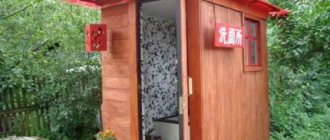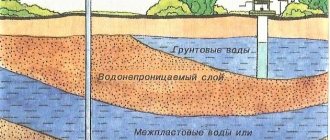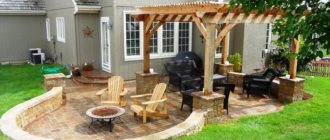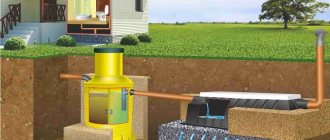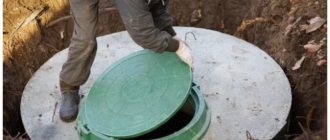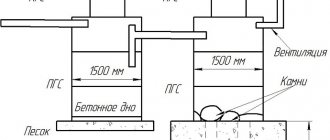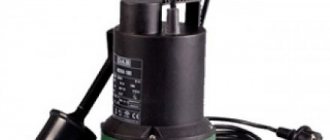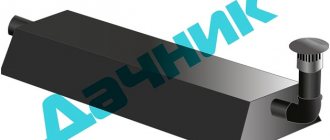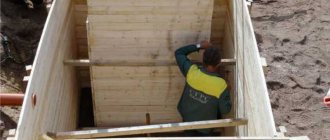However, it should be remembered that when decorating a sewer hatch, care must be taken to ensure access to communication systems regardless of the time of year, but the hatch itself may be hidden from view. In this regard, it is necessary to think through and carefully calculate all the elements of the decorating structure. Here it is worth considering exactly where the well is located and what material its cover is made of.
How to disguise a cesspool
Whatever the sewer system, an unsightly manhole is always present.
Even being very neat, it does not add beauty to the landscape, but rather resembles an eyesore rather than requiring urgent action to be taken. And measures are taken by planting place X with climbing plants, hiding it behind a fence (at the same time, they often forget about the need to ensure free access to the structure).
A very original solution, but this flower car will have to be moved more than once (every time you need to open the hatch)
Decor of an ordinary cesspool
The vintage look of brickwork is achieved very quickly - this is facilitated by high humidity (the brick is overgrown with moss, as if by magic). But this is only possible in a primitive drainage (forbidden!) cesspool. In other situations, the brick will remain banal.
The lid is made of varnished board. The hatch is decorated with a flower arrangement located in a plastic container (easy to move). Decorating the cesspool hatch with vegetation is the most common option. And perhaps the simplest. It is not necessary to come up with something extra original - just put a garden composition on the hatch and plant ground cover plants around it.
You can do it even simpler - cover the unsightly area with rolled lawn.
Under one of these decorative stumps there is a sewer hatch.
However, these methods are good when the structure does not protrude upward, like the hatches of finished septic tanks.
Sewage treatment plant hatch
If the sewer cover “rises” above the surface, trellises and climbing plants (especially hops, thick, beautiful and growing incredibly quickly) help.
If the hatch is small, you can install a hollow decorative flowerpot (with a composition) on top. These pots are made of lightweight material - polystone. Possessing the properties of stone (strength, weather resistance), it is almost weightless and flexible in processing: wood, brick, plaster, concrete - the material is identical to any surface. It is from polystone that massive-looking but very light flowerpots, gnomes, and small architectural forms used by landscape designers are made.
Polystone is an artificial stone and is practically indistinguishable from natural stone. The hatch can be hidden under a picturesque “stone” block.
A simple but nice solution
Also the simplest thing is to install a flower bed on a hatch, and an interesting thing is to install a flower bed turned upside down (several of them nearby - and it’s not clear what the hatch is under, but it looks non-standard, aesthetically pleasing).
A couple of figures, and the sewer hatch turns into a decorative item
Behind the gate is a compost pit
This pile of compost is hiding behind a bush.
Design selection
The hatch for carrying out preventive inspections and other types of audit work can be:
- depending on installation location:
floor Such structures are characterized by the complexity of installation, since in addition to the safety margin, it is necessary to additionally ensure complete tightness of the equipment. Used when water or sewer pipes pass through the floor;
Floor inspection
ceiling As a rule, such a hatch is installed when installing a ventilation system. The main difference is the low weight of the structure;
Inspection on the ceiling
wall-mounted The most popular and frequently used type. Wall structures can be made in different sizes and shapes. No special sealing is required. There are no special requirements for the design, other than ease of use.
Inspection on the bathroom wall
- depending on the design there are:
hidden hatches. A sanitary hatch under the tile allows you to get a complete picture of the room and not stand out from the overall interior;
Hatch mounted under tiles
- open standard hatches located in the most convenient place for performing work;
- viewing windows. Any transparent material is used as a door. There is no need to open the door to receive information.
- Depending on the form there are:
- square designs;
- rectangular structures;
- designs of any other shape specified by the manufacturer.
Septic tank decor options
You can decorate manholes with natural materials or flowers. Most often, when decorating with flowers, a low box or some kind of container is selected, which is then placed on top of a hatch or septic tank. In addition to flowers, the decor can be artificial moss, climbing plants, decorative barrels, sections of wood stylized as stumps.
Of course, the most interesting solutions for decorating septic tanks are: artificial stone, shaped fiberglass lids, and figurines for the garden. These can be fairy tale heroes, three-dimensional figures, funny animals, and entire compositions. A decorative manhole cover can be a natural element. The flowerbed hatches are covered with rolled lawn, or another cover on which soil is poured. To decorate the hatch, various wooden elements are also used. You can make a wooden well, a cart, a mill, a small bridge.
It is more economical to lay a rolled lawn only in the summer, and it is better to remove it in the fall. If you use a real grass lawn, you must first pour soil onto the wooden lid or box, otherwise the grass will dry out. You can also place a low flowerpot with flowers on the lid.
Now, in a crisis, not everyone can afford expensive site decoration, so anything can be suitable for decoration: plastic bottles, barrels, used tires, materials left over from construction. The main thing is that the owners of the house like it.
Artificial stones for hatches are considered one of the most popular and durable options. Artificial stone is a decorative cover for sewer manholes. Although it looks very massive on the outside, in fact the artificial stone is not too heavy, since it is completely empty inside. Artificial stone, which can be bought in a store, is decorated with cobalt, granite, steppe boulder, sandstone, cobalt, jasper, and limestone. Such decorative stones are produced from polymers and chips of natural stones.
Around the place where the artificial stone is located, it is better to sow grass or lay a rolled lawn. This place looks good if you surround the artificial stone with plants and plant bushes nearby. Don’t forget to secure the artificial stone with fasteners to the base, or even to the ground, so that in strong winds the structure will remain in place.
DIY artificial stone master class
The stores sell a large number of designer items stylized as artificial stone. But they are expensive and fragile, as they are made of polymer resin with the addition of natural stone chips. If you accidentally step on such a “stone” - and that’s it - the product crunches. This decor for septic tanks, like artificial stone, can be done with your own hands. Artificial stone is used to hide septic tanks, sewer hatches, or unsightly places in the garden.
To work you will need:
- Wire (six wire rod).
- Metal mesh.
- Pliers.
- A can of polyurethane foam.
- Cement.
- River sand.
- Acrylic, acrylic-silicone, or oil paint.
- Brushes.
We will make an imitation of a limestone boulder. Our entire structure is mounted on a metal frame, which is made of wire rod six (springs are also made from it). A contour of any shape is made: using pliers, we bend the wire, giving it the appearance of a stone. We make an outline and attach additional edges to it. All this is welded or fastened with the same wire using pliers. All this is covered with a metal mesh. The fraction is not so important, since the main load-bearing element is construction foam. It is applied to a metal frame. Then you need to wait until the foam hardens.
After the structure has hardened, we begin to make edges using a knife, giving it the appearance of stone. After this, we dilute cement milk in a bucket, the thickness of which resembles liquid kefir. For this we take 1 part cement and 4 parts water. We impregnate our artificial stone with cement laitance using a brush. Then, after the stone has dried, we apply more cement paste with sand on top (cement - 1 part, sand - 3 parts, vrda - 0.5 parts).
This is done in order to give the product the final texture of stone. Then, after the artificial stone has dried, it can be painted with acrylic, oil, or acrylic-silicone paint. After painting, it would be a good idea to seal the structure with a layer of concrete sealant. But you can leave it without such coverage.
The video shows country house decor, including septic tank decor.
? Decor and decorations for the garden - DIY country ideas
Finally the weather is getting better. Yesterday there was sun all day, this morning! Beauty! SPRING has come...It's worrying, and even a very huge amount of snow. Let's float, however...We'll have to dig ditches and drain the water. But sooner or later everything fades away. It's time to think about sprucing up the area (I mean everything about mine). I was concerned that near the house we have two hatches - a sewer (for the septic tank and a water supply. And they stick out like an eyesore. In the most visible place, and they also “eat up” part of the territory. I turned to my dear friend - the Internet and it turns out that I’m not the only one. I’ve looked at a few ideas, I’m sharing them!
A little advertising Fortuna - St. Petersburg LLC supplies equipment and materials for water supply, heating and sewerage systems. Serious, reliable company. By ordering here РІРЋРє чугунный канализацРеонный, you will be satisfied with the speed of execution of your order. Quality guaranteed!
Manhole covers can be used as stands for indoor plants, containers with garden flowers, unusual stones, figurines, solar-powered lanterns, etc. The ground near the hatch is much warmer, so plants growing next to it rarely freeze out in winter, even in severe frosts, and are the first to bloom in early spring. Trees cannot be planted here, as there are pipes underground. And there is no need to restrict access to hatches. You can place primroses and other bulbous plants around manhole covers. Use special planting baskets, which in emergency situations can be easily removed from the ground along with all its contents. You can decorate the hatch protruding above the ground with ground cover plants and a few flat stones.
9.
How to properly decorate a sewer hatch
Decorative stone-boulder for camouflaging a sewer manhole
To decorate the sewer manholes on your site, you can buy ready-made camouflage elements or do the work yourself.
Finished products
For those who don’t want to waste time masking an unsightly hatch, there are a lot of already made elements:
- Polymer stones-boulders. They look original, withstand temperature fluctuations, and retain their presentation for a long time. The main thing is to choose the right stone diameter, color and size. Additionally, you can place a few more similar natural boulders around the site, or decorate the area by building a nice alpine slide nearby.
- Dwarfs, little men, whimsical heroes. Especially good if there are children in the house. This disguise creates the atmosphere of a fairy tale.
- Chests or wells. Unusual decor options in a certain style.
- Interesting garden bridges.
Artificial lawn grass in the form of a mat.
After purchasing the finished product, all that remains is to install it on top of the manhole cover.
DIY plant decor
Decorating with plants
There are a lot of ideas for decorating a manhole. The most popular of them:
- Planting mini-lawns on the cover. Suitable for polymer hatches that have special recesses. With this technique you can beautifully decorate even a small garden. It is advisable to place annual plants with a small root system in mini-lawns. Their color can be changed every year.
- Planting low-growing ornamental plants. They must be placed on the side from which technical maintenance work on the system is not carried out. You can use juniper or dwarf Christmas trees of the Nidiformis and Barri varieties. You can also plant irises, dotted loosestrife or caustic sedum not far from the sewer well. These are perennial crops that quickly recover from accidental mechanical impacts. A special shrub that spreads in growth, stephanandra, performs well in this regard. As it grows, it will cover the hatch. To open the well, you can simply move the branches of the crop to the sides.
Wooden decor
Stump for masking the lid
Wood is whimsical as a camouflage material. But with proper processing, a nice element will last for more than one year. Options you can use:
- Cut down a small height (stump with roots). The wood must first be prepared: dried in the sun, then coated with fire retardants and varnish. The main thing is that the cut section is slightly larger than the diameter of the lid. You can buy artificial polymer and very light stump.
- Snag. It will also look original in landscape garden design.
- Decorative well. The master can make a low house for an artificial source himself.
Wooden elements always look authentic.
Paints
Decorating a manhole with a pattern
If the sewer cover is made of cast iron and is located directly on the sidewalk path, there is only one way out - pick up a brush and disguise the element with a pattern. You can show your imagination and paint sewer disks in any theme. It could be flowers, an ornament, or just monochrome. It all depends on the talent of the master and the desire to make your yard a little brighter, more interesting, and more fun.
Using plants to disguise a hatch
In this case, you can not only hide the sewer hatch well, but also decorate the place where it is located. For example, right in the center of a plot with a lawn. In this case, in this place you can arrange a round flower bed with shrubs and various plants. Barberry with its golden or red hue, spirea, cinquefoil, juniper and other species will look spectacular here. When the plants grow, they will reliably hide the hatch, becoming the epicenter of attention.
You can also plant some representative of tall perennial plants nearby, for example, astilbe. But what’s interesting is that if astilbes are damaged during technical work, they are able to recover very quickly and again delight with their beautiful appearance.
In addition to the plants listed, you can use some others:
- marsh iris;
- point loosestrife;
- sedum acrid.
They also recover quickly and do not require close care.
From shrubs you can plant stephanandra. This creeping plant grows quite quickly, but to gain access to the hatch, you just need to move its branches to the side.
If there is a septic tank on the site, then many manufacturers include a flowerbed cover, which is installed instead of the usual one. In this case, you only need to pour fertile soil into it and plant seeds of plants that have shallow roots. And after some time the lid will bloom with bright shades.
Cover decoration elements
You can decorate septic tank covers with your own hands. Decorative elements can be:
- fake diamond;
- mobile flower bed;
- compositions of garden figurines and other additional elements.
Fake diamond
A boulder or artificial stone is a structure that is hollow inside and looks like a real stone from above. The advantages of this decor are:
- low cost;
- ease of installation. The stone is simply placed on top of the septic tank lid;
Masking the septic tank lid with artificial stone
- light weight, which allows you to remove the decorative element in the shortest possible time and without outside help for periodic maintenance of the treatment plant;
- non-susceptibility of the material to temperature changes and precipitation. The product service life is more than 25 years;
- a variety of shapes and colors, which allows you to choose the best option for the landscape of your garden plot.
You can make a stone for decorating the septic tank lid yourself. To do this you will need to prepare:
- cement mortar;
- special shape (you can use any shape, for example, a car tire);
- stone chips.
The manufacturing process is as follows:
- the bottom of the shape of the future boulder is covered with small stones or crumbs;
- the crumb is poured with concrete;
- After the cement mortar has completely dried, the boulder is removed from the mold and placed in the place prepared for it.
Decorative stone production scheme
How to make a boulder from polyurethane foam and a metal frame, watch the video.
Mobile flower bed
A decorative portable flowerbed can be made from various materials in accordance with the wishes of the owner of the site. The most commonly used:
- car tires;
- wooden boxes;
- baskets;
- umbrellas;
- barrels and so on.
Annual flowers with a small root system are planted in the prepared flowerbed frame. The finished structure is installed on the lid of the septic tank.
Mobile flower bed for decorating the lid of a septic tank
Decorating with compositions
Another decorative element can be various garden figurines, which can be purchased in stores or made from scrap materials with your own hands.
Figurines for decoration
Finished figurines are usually made of polymers and differ in:
- resistance to temperature changes;
- resistance to sunlight;
- resistance to precipitation.
From ready-made figurines you can build various compositions using decorative stone and/or a portable flower bed.
Artificial stone lid with garden figurine and plant
So, it is mandatory to install a cover at a wastewater treatment plant. To prevent the lid from spoiling the appearance of the area, it can be decorated with various elements in accordance with the overall design concept. Using various decorative elements, you can also “hide” filtration fields, sewer pipes, inspection and inspection wells, and so on.
Color
The boulders will not necessarily be made to match the color of some natural rock.
Imitations can be painted in different tones, and they may well have different images on them. As one example, there are drawings that imitate rock paintings left by ancient people. It is not necessary to order false boulders with such an imitation - it can be done independently, using stable, weather-resistant, water-resistant paints. A rather unusual solution is to camouflage sewer manhole covers with artificial boulders that will glow in the dark. In daylight, the products look like ordinary stone, but with the onset of darkness they begin to glow with a greenish or bluish light. This effect is achieved due to phosphorescent substances added to the material.
DIY septic tank decor
You don’t have to spend money on decorative elements, but try to make the lid yourself.
The material for this is selected whatever is at hand. Just be sure to provide the ability to move the lid when cleaning needs to be done. It is best to use old tires for this. Having selected the most suitable tire in diameter, install it on the hatch, securing the cellophane on the bottom side in advance. After this, soil is poured inside the tire and flowers with a shallow root system are planted. If such a desire arises, the outer surface of such a flower bed can be painted in any color or decorated with small pebbles. This homemade septic tank decor will wonderfully decorate a suburban area.
You can also make a structure in the form of a hemisphere from wire. It should hinge in the same way as the hatch cover. Decorate it with flowers or climbing ornamental plants.
When not to mask a manhole cover
For the convenience of the master, in some cases it is better to leave the sewer cover without any decoration at all, or to take special care in masking it. You need to be extremely careful in the following cases:
- The hatch is an element of the inspection well, which you have to look into often.
- The cover is located on the roadway of the allotment. You can use paints or immediately buy a hatch that imitates tiles, stone, and other elements. Such elements cannot be masked otherwise.
- The sewer element serves to drain storm water on the site. Through its holes, water penetrates into the wells and goes further along the channels. If you close technical gaps with masking, this will disrupt the operation of the drainage system.
- The hatch is located on a very large area, there are several of them, and the master does not have a plan for the sewer system. In this case, the lid may simply get lost and you will have to “shovel” the entire plot in the event of an emergency.
It is prohibited to decorate sewer covers belonging to municipal territory. They should have 24/7 access for utility employees. Even if this hatch is located near the gate of a suburban area.
Cover-flower bed
The septic tank cover for a private home can be located not only in the middle of the lawn, but also in the flower garden. In this case, you can disguise it in several ways. The fastest of them is installing a false flower bed. Essentially, this is a large container with soil into which annuals are planted. It is installed directly on the hatch and decorated around the edges. As such a container, you can use a basin, bucket, flowerpot, bag of soil, or a specially purchased lid with a recess.
The main thing when installing such a structure is to make it easily dismountable, because during the season you may need to open the septic tank lid several times.
Examples of covers in photos and videos
The hatch can be decorated with pebbles collected from the sea, the laid out picture can be additionally colored Source proekt-sam.ru
Have you seen the cat? Source postroika.biz
Round dance of forest animals on a stump Source moikolodets.ru
Thinker stones will give you a reason to think Source postroika.biz
Did you call a plumber? Source dcgate.pp.ua
A beautiful mill or lighthouse can become a decoration for the garden Source nastanova.com
A cheerful miner dog is always on guard for a good mood Source masterovgorod.ru
A well house made of timber is a great idea near a wooden house Source zen.yandex.ru
Pumpkin is waiting for his Cinderella Source fedsp.com
A decorative hatch can additionally become a flower bed Source www.sibdesigner.ru
Decor selection criteria
Ready-made decorative hatch cover
The choice of the final camouflage option depends on several important factors:
- General style of landscape design at a summer cottage. The decorative element should fit into it and look organic.
- Manhole cover material. For polymer products, it is better to choose lighter camouflage options, although plastic mixed with a composite can withstand high loads. Excessively heavy elements can damage the surface of the sewer cover.
- The complexity of the process. If the master likes to tinker and show his imagination, you can opt for non-standard, intricate options. If you want to do everything in no time, it is recommended to simply purchase a ready-made solution.
- Durability and attractiveness of the final (final) design. The decor is not made for one or two years, so it is worth considering the material’s resistance to temperature changes, sun, and precipitation.
- Weight of the finished structure. If you need to get under the hatch cover, you will have to lift the decor. It is advisable to do without outside help. After all, at the right time it may not be there.
You should rely on your financial capabilities. For some, it is acceptable to close a sewer hatch within 50,000 rubles, while others are able to manage only a few hundred or thousand.
Decorative hatches
The appearance of a metal cover can greatly ruin the landscape design of the site. But today, designers together with construction companies have found an interesting approach to solving this problem. And it consists in making decorative hatches of an unusual shape.
Depending on the material of manufacture, decorative hatches can be:
- cast iron;
- sand-polymer.
Cast iron hatch
The great popularity of cast iron hatches is known to every city dweller. Often such covers are located not only on sidewalks, but also on roads. They must be strong enough to withstand the entire vehicle. Therefore, they become thick, which leads to a significant increase in weight.
But if a true master of his craft gets down to business, then an ordinary sewer cover will become a real decorative element for any garden plot. Some cities can already boast of the original form of hatches, among which you can find entire sculptures of people or animals. So why not buy such a cover for your garden plot to pleasantly surprise your neighbors.
Sand-polymer hatch. You don’t have to worry that such a hatch will be stolen.
Sand-polymer products have a low cost, a fairly long service life and good strength. As some manufacturers note, such covers can last up to 20 years and withstand weights of up to 15 tons.
As for the weight, it is also considerable, about 50 kilograms, which brings their weight closer to cast iron hatches. But unlike the latter, sand-polymer covers are stronger and more durable. It is impossible to slip on them when wet and they are of no value.
But what is typical is that decorative sand-polymer hatches have a wide range of colors. They can naturally imitate the surface of asphalt, lawn or paving slabs.
What needs to be done
Insulation of a sewer can be done in several ways:
- insulate the hatch cover;
- insulate the walls of the well itself.
It will be better to combine both methods. In such a case, you can be completely sure that the well will not freeze during winter.
As an additional precaution, you should also take care of the thermal insulation of sewer pipes
Cover insulation
To prevent cool air from entering the well, you should take care of a high-quality cover; a concrete cover is not suitable for use in winter. It would be right to purchase a ready-made insulated product. If this does not work, you can make a similar cover without outside help.
To do this you will need:
- wooden boards or two sheets of stainless metal;
- expanded polystyrene.
Everything is made extremely simply: you make a lid of the required shape and size from wood (or metal). It should close the drain well hatch very tightly.
Attach polystyrene foam to the resulting lid and cover it with another layer of wood. This cover is extremely simple to design, but it protects the sewer well from frost.
If possible, you can make a small decorative house that will cover the above-ground part of the well, protecting it from frost. The easiest way to make such a wooden house. First of all, it is very easy, and second, the material does not require additional insulation.
Wall insulation
As we have already said, it is best to insulate the walls of the septic tank during installation.
For example, let’s take a well made of concrete rings, since this particular tone is considered very popular.
The main sequence of actions is as follows:
- There must be a hole around an already installed well, the width of which is up to 0.5 m.
- The insulation of a simple well with penoplex is shown. The lower ring is carefully covered with thermal insulating material. This can be polystyrene shell, expanded polystyrene. The selection depends only on you. The gaps between sheets of insulation material must be sealed with installation foam. After which the heat insulator should be covered with a layer of plaster and protection from the negative effects of moisture.
- We insulate the rest of the well in the same way.
If you plan to insulate a structure that has been installed for a long time, you will need to dig a pit with a depth of at least 1.5 meters near it and thermally insulate this part.
The main thing: 1.5 m is the average depth of freezing of the ground, therefore you should not limit yourself to insulating only the upper ring of concrete.
Conclusion
Insulating a sewer well is very simple. The process does not take a lot of time and effort, and does not require expensive materials. But thanks to high-quality thermal insulation, your sewer system can last longer.
Features of the design and operation of hatches
Hatches as elements of the support-cover type are distinguished by a well-thought-out design that does not cause mechanical damage to the reinforced concrete base of the well, helping to extend its service life. The design of the hatch means it can be removed using a hook by one person, with the exception of heavy and super-heavy products, the weight of which can reach 155 kg. From a safety point of view, the surface of the elements should have a relief appearance, while the height of the protruding elements can vary from 3 to 8 mm. Also, according to state standards, a convex relief can occupy from 10% to 70% of the total area of the cover, preventing a person or vehicle from slipping when moving.
According to design features and shape, cast iron hatches are divided into the following classes according to EN124:
- Medium hatch B125 with a product weight of 72 kg, with a load of up to 12.5 tons;
- Lightweight hatch A15 (LM) of small-sized design, with a nominal load of up to 1.5 tons;
- Light hatch A15 (L) normal, with a rated load of up to 1.5 tons;
- Heavy hatch C and T 250 with a hinged structure, the weight of which is 120 kg, the maximum working load of which is 25 tons;
- Main heavy hatch D 400 with a weight of 140 kg;
- Repair insert R;
- Large lattice storm water inlet DB 1 and 2, rated load 12.5t;
- Small lattice storm water inlet A15 (D);
- Main storm water inlet DM1;
- Extra-heavy storm water inlet DM2.
There are cast iron hatches of various shapes, in the form of full circles, round elements with beveled edges, as well as square products. In addition, some models are equipped with a locking feature or have a locking device function. Hatch locks have three design options:
- Lock with a secret;
- Security bolt;
- Spacer design of the mechanism.
How to make a cesspool cover from concrete
There is a need for invention, so the lids, and with them the hatches, are made from boards, metal sheets and other flat materials. However, a loosely fitting lid shows a steady tendency to leak sewer aromas, which does not delight even those who made this part.
To prevent smells from intruding as an inappropriate note into the melody of country life, tightness is required. The lid is the most complex element of a cesspool made of concrete. If pouring the bottom, assembling the formwork and casting the walls, although labor-intensive, is not technologically difficult (the formwork has a support), then you have to make the lid by weight.
The work is somewhat simplified by a corrugated sheet. They write that it even increases strength, but a logical question arises - why strength if they do not intend to put heavy machines or other loads on the lid. However, these are lyrics. It’s really much more convenient with a sheet of corrugated board.
The first step is to cover the pit - install the boards end-to-end so that the lid extends 20–30 cm beyond the walls (so that the weight load is partially on the ground). Instead of boards, the pit can be covered with profile pipes and a steel angle (high load-bearing capacity - concrete weighs a lot).
Overlap
Planks or a sheet of corrugated sheeting are laid flat on the roofing (corrugated sheeting is a permanent part, which also simplifies the process) and the formwork is assembled, not forgetting about the holes for the hatch and communications. Then a reinforcing mesh is knitted (or welded) (reinforcement - 12 mm, pitch - 15–20 cm), and then poured with concrete.
Pouring concrete
Another option is to cast the slab separately and then install it on the walls. In this case, all communications are connected and waterproofing work is carried out before installing the cover.
Monolithic construction and in Africa - monolithic construction. They build it the same way everywhere. The guys made a very nice scavenger hunt. They cast the cover separately (not forgetting about the mounting brackets) and before installing it, they connected all the pipes and made waterproofing.
When deciding in favor of a monolithic pit, keep in mind that concrete dries for 28 days (ideally) and all this time you need to create optimal conditions for it.
All of the above also answers the question of how to make a lid for a cesspool out of brick.
Materials for making the lid
To make the lid, you can use a wide variety of building materials, which are most suitable in each specific case:
- Tree.
- Metal.
- Plastic.
- Plywood.
- Chipboard.
The most common option in the recent past is a wooden lid. This material is environmentally friendly, affordable and easy to process. Also, the wooden structure above the well looks very colorful and original, especially if the homeowner uses imagination when decorating the log house. You can also cut a hinged lid from sheet metal, polymer sheets - hardboard, textolite, installed on a wooden or steel frame.
If the well shaft is made of concrete casing rings, then you don’t have to worry too much and cover it with a standard concrete cover with a hatch. Of course, such a structure will not look very aesthetically pleasing. But, if the well is located deep in the garden plot and is not noticeable to guests and household members, this option is quite acceptable. The main advantage in this case is the simplicity of the device and durability of operation.
Description
It so happened that humanity has become thoroughly accustomed to various engineering systems and can go nowhere without sewerage or water supply (at least cold water). But when you are planning to create a truly beautiful, even unique in design sense, site, you cannot do without hatches protruding in the most unexpected places. It doesn’t matter whether they protrude above ground level or not, in any case it’s ugly.
There is a way out, and it’s quite simple - cover the hatch or well with some kind of decoration. This will not only allow you to hide a useful, but ugly creation of construction engineering, but will also make it possible to build the entire composition of the site around a decorative hatch for wells.
Guests will not even guess that under the fairy-tale stump house of the forest elves there is an ordinary well hidden Source gazburg.ru
The photo shows an option of how to beautifully and organically fit a hatch into the landscape of a personal plot. Such a cover can be easily lifted, giving access to engineering systems, which means that repair of communications will be possible in any situation. Moreover, there are configurations that can withstand heavy weight (about 100-150 kg). Such hatches are an excellent opportunity to create artificial wooden stumps on your site as a place to relax or to create a fairy-tale meadow, which, in addition to design and aesthetic functions, will protect engineering systems from dust, dirt, and snow.
See also: Catalog of companies that specialize in water supply and sewerage.
Interesting wood decor ideas
If the type of stones does not match the personal taste preferences of the owner of the summer cottage, then you can use a more beautiful material - wood. Besides, finding some kind of snag or stump is not so difficult. Otherwise, they, like artificial boulders, can be purchased in the store. In appearance, decorative stumps do not differ from real wood, and they have a fairly long service life. In addition, artificial products specially provide platforms or recesses for flower pots. In any case, each gardener will decide for himself whether he prefers the look of natural or artificial decor.
If you use your imagination, you can make various shapes from wood. For example, you can throw a small bridge over the lid. It is ideal when a stone stream approaches the well.
We use an old barrel for decoration:
If there is an old barrel that has already fallen apart, then it will make a good lid, and one made with your own hands.
- First you need to cut the wooden tub in the middle or a little lower and let it dry well.
- Then you should tighten the boards, stepping back a little from the cut line, using thick copper wire.
- After this, the product must be treated with a special antiseptic composition and then covered with drying oil. For greater reliability, several layers - 3-4 will be enough. This will protect the tree from rotting.
Natural and artificial materials
Bamboo, cork, natural dyes, wood go well with country, classic, Provençal, and colonial styles. Cones, bark, stones can create an original composition. Stumps and sections of logs can successfully close the lid of a small hatch. For durability, all wooden parts are coated with protective compounds.
On a note!
Natural materials look good next to wickerwork, furniture, forged elements, and rough fabric.
You may be interested in: Do-it-yourself landscaping of a summer cottage: interesting options Using thuja in landscape design: how and where to plant thuja in a garden plot Laying paving slabs with your own hands: step-by-step instructions with photos
Unnecessary things that have long since become dusty in the attic will help create decor that disguises not only well covers, but also all elements protruding above the surface:
- garden sculptures, busts;
- artificial flowers, dilapidated furniture;
- car tires, leftover building materials;
- old dishes, plastic bottles.
Old children's baths, metal and plastic basins can easily turn into an artificial pond. And by purchasing a small pump or an aquarium pump for 200-300 rubles, you can organize a whole cascade of waterfalls with a fountain.
You can make original flower beds from iron buckets, plastic bottles, unnecessary containers, and old shoes.
Old car tires are very often used to decorate the territory, equip play areas, and for economic purposes. Flower beds, drinking bowls, animal feeders, arrangement of beds for vegetables, garden crops. Tables, ottomans, and chairs made from tires can last for decades, and their manufacture does not cause much difficulty. At children's playgrounds, sandboxes, swings, tunnels, bicycle parking, and airbags are made from tires. Craftsmen carve complex figures of birds, animals, fairy tale and cartoon characters.
